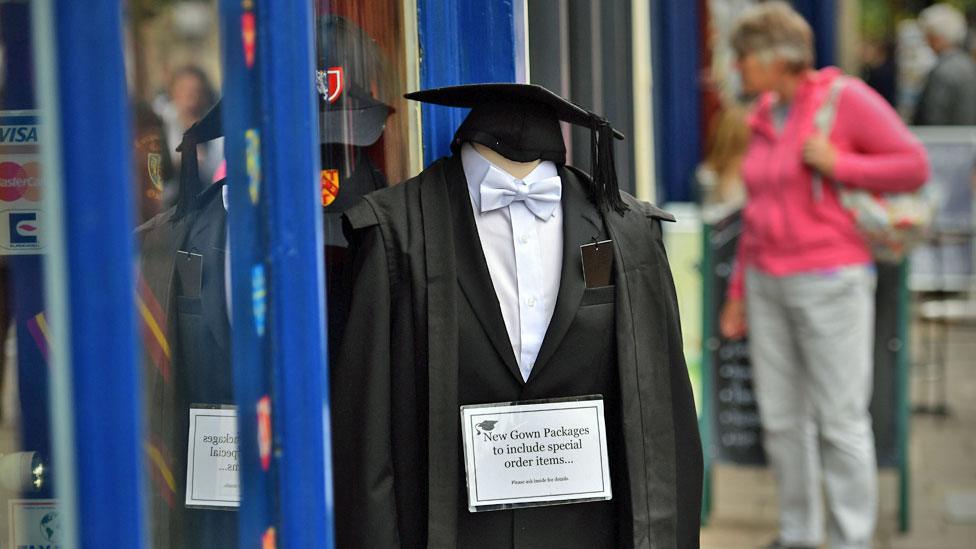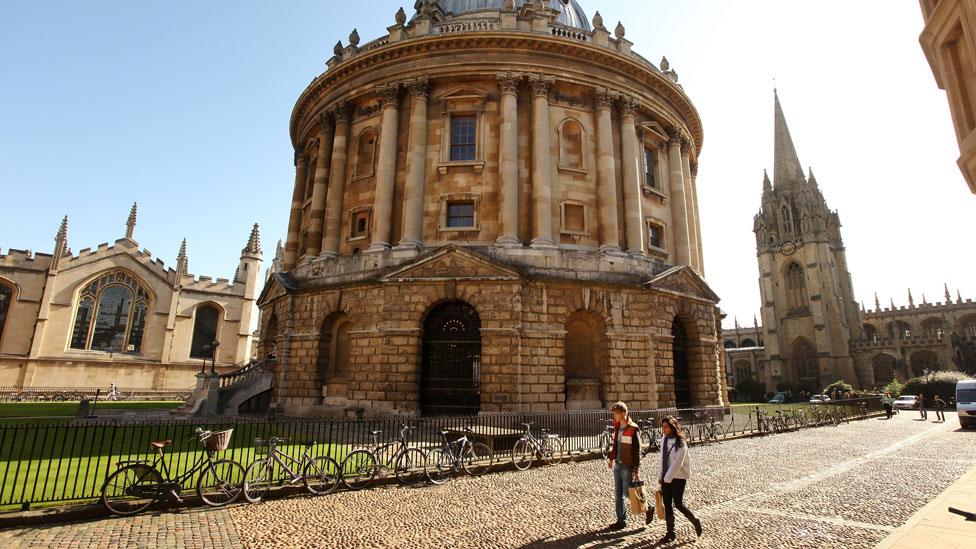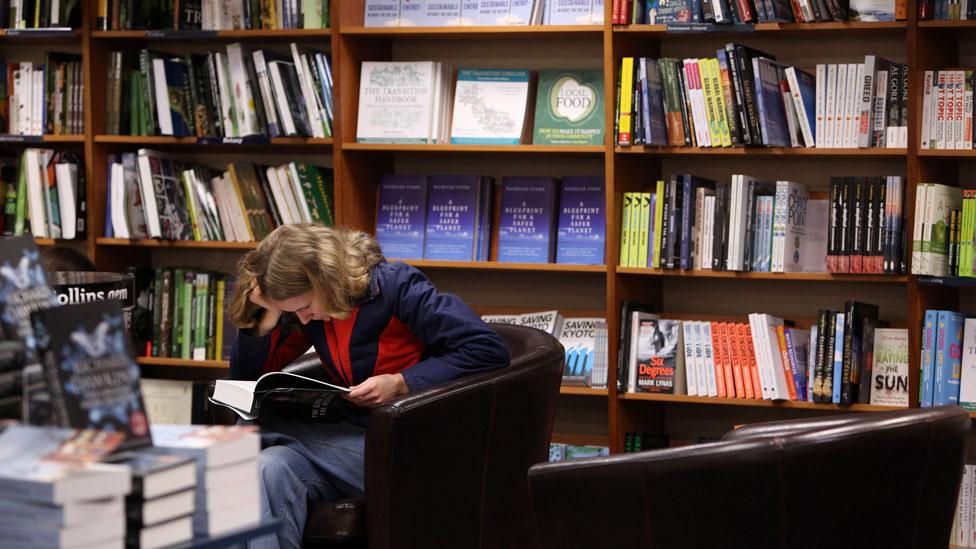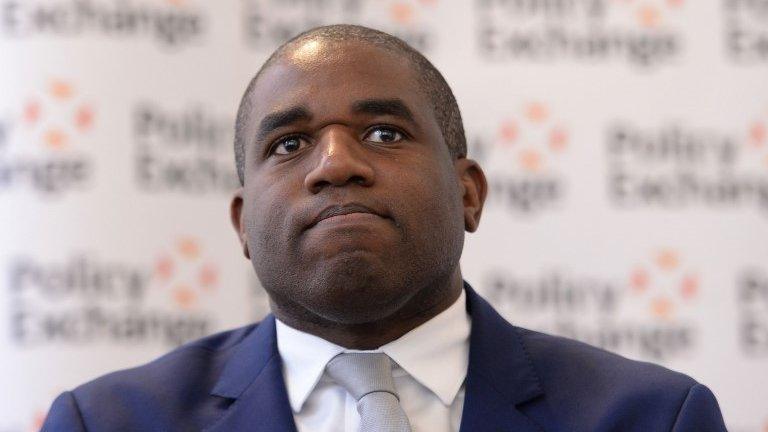Oxbridge 'over-recruits from eight schools'
- Published
- comments

Oxford and Cambridge are being accused of being so socially exclusive that they recruit more students from eight top schools than almost 3,000 other UK state schools put together.
The Sutton Trust social mobility charity says the leading universities are failing to attract a wide enough range of talent.
Trust founder Sir Peter Lampl said all young people needed a "fair chance".
Oxford University said they were "very aware" that they "must work harder".
The study examined Oxford and Cambridge admissions data between 2015 and 2017 and found a handful of schools, mostly private, disproportionately dominating the number of places awarded.
The Sutton Trust says pupils from eight schools filled 1,310 Oxbridge places over three years, compared with 1,220 from 2,900 other schools.

These 2,900 schools were those with historically few admissions to Oxbridge - and accounted for about three-quarters of secondary schools.
In the past three years, Oxford and Cambridge admitted a total of 19,851 undergraduates, with the remainder of places coming from other private schools and top performing state schools and colleges.

Which are the schools with the most Oxbridge admissions?
The charity was using anonymised admissions data - but it says it believes most of these eight places were private schools plus a couple of big state sixth-form colleges.
Using published figures, among the schools and colleges with the highest number of Oxbridge admissions are:
Westminster School, London (independent) - an average of 70-80 pupils each year have been offered places at Oxford and Cambridge in the last five years, the school says
Eton College, Berkshire (independent) - in 2014, 82 students were accepted to Oxbridge. The following year 68 were accepted
Hills Road Sixth Form College, Cambridge (state sixth form college) - an average 60 pupils receive Oxbridge offers, the school says
St Paul's School, London (independent) - 53 students went to Oxbridge in 2016 and 41 in 2015
Peter Symonds College, Hampshire (state sixth form college) - an average of 48 students received offers from Oxbridge over the past three years
St Paul's Girls' School, London (independent) - an average of 45 students went to Oxbridge each year between 2015 and 2017
King's College School, London (independent) - sent 48 students to Oxbridge in 2017
Magdalen College School, Oxford (independent) - 44 students went to Oxbridge in 2018

The research also found that high-achieving independent school pupils were twice as likely as state school pupils to apply to Oxford and Cambridge, even with the same ability and predicted grades.
The report shows the imbalance in admissions:
7% of all UK pupils attend private schools
18% of those taking A-levels are at private school
34% of Oxbridge applications are from private school
42% of Oxbridge places go to private school pupils
The study says there are some parts of the country where particularly few young state-educated people get places.
These include:
Halton
Knowsley
Lincolnshire
North Lincolnshire
Portsmouth
Rochdale
Rutland
Salford
Southampton
Thurrock
The study blames a lack of advice and guidance for applicants and calls for better information about what is required for entry and for admissions to take into account young people's backgrounds.

"If we are to ensure that all young people, regardless of their background, have a fair chance of getting in to our top universities, we need to address the patchwork of higher education guidance and support," said Sir Peter.
"All young people, regardless of what area they grow up in, or what school they go to, should have access to high quality personal guidance that allows them to make the best informed choices about their future."

State v private school approach
William Baldwin, principal of non-selective state sixth form Brighton, Hove and Sussex Sixth Form College (BHASVIC) said offers from Oxbridge "began to snowball" in recent years.
Last year 57 students were offered Oxbridge places and 27 of those were from less affluent backgrounds.
Mr Baldwin put the success down to dedicating college resources to admissions and employing a full-time co-ordinator of Oxbridge applications.
Students self-select their interest in applying and then receive bespoke tutorial sessions on personal statements, extra-curricular activities and interview practice, he said.
Andrew Halls, head master of selective independent school King's College School said his school also gave extra lessons and advice sessions to students wanting to apply to Oxbridge. The school sent 48 students to Oxbridge in 2017.
He said the selective nature of the school played a part: "These kids are very bright anyway. In January about 800 pupils will sit for about 80-90 places."
He also stressed the importance of teachers who could "demystify" the Oxbridge process.
"Schools like King's do understand the structures of Oxbridge because they've been historically sending children there for hundreds of years."

Martin Williams, Oxford University's pro-vice-chancellor for education, said the university accepted the need to do more to widen access.
"We are very much aware that Oxford must work harder to attract a more representative selection of students from across the UK," said Prof Williams.
Oxford runs summer schools to encourage more disadvantaged students to apply - and the university says there are plans to attract more students from places where it had recruited few students in the past.
The university says it spends £7m per year on outreach schemes and is promising a new "detailed action plan" with changes to make sure there are places for students of "outstanding potential from all backgrounds".
A spokesman for the University of Cambridge welcomed the idea that "more support should be made available to students before they choose their A-level subjects and agree there should be more provision of careers advice".
But Cambridge rejected "lowering grade requirements", saying this would "place unfair pressure on students and that is something the university cannot support".
Removing barriers
Education Secretary Damian Hinds, speaking on Thursday, said leading universities should accept students with the new technical qualifications, known as T-levels.
He said it would be an "error" to have a "blanket rejection" of young people applying with the new vocational exams, where they were relevant.
Oxford University says it is waiting to see how the T-levels develop before making a decision.
Mr Hinds was launching plans for an overhaul of vocational education - saying such exams needed to be of sufficiently high quality to be held in the same esteem as A-levels and academic qualifications.
He warned of a "plethora of mediocre" qualifications that were not well understood by either the public or employers but said, he wanted to remove "false barriers" between academic and vocational qualifications and that both could be routes into higher education.
On the Sutton Trust report, Mr Hinds said: "Whilst potential and talent is evenly spread, the opportunities to make the most of it sometimes aren't.
"I want universities to work with us, consider the data carefully and look at their own admissions policies to work out what can be done to ensure that their university is open to everyone who has the potential, no matter their background or where they are from."
Tim Bradshaw, chief executive of the Russell Group of leading universities, said: "We want to recruit students with potential and drive, regardless of background, and we are working hard to improve social mobility."
- Published27 November 2018

- Published23 May 2018
